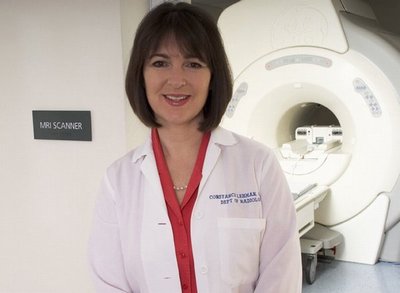October 11, 2007
MRI helps detect breast cancer in women at high risk
If a woman has been newly diagnosed with cancer in one breast, magnetic resonance imaging (MRI) of the other breast may show cancer that the mammogram missed, according to a UW-led international study that was published in the New England Journal of Medicine in March. This means that both cancers can be diagnosed at the same time, so women can have one round of treatment instead of two, says UW radiologist Dr. Constance Lehman, principal investigator in the American College of Radiology Imaging Network study.
Lehman and other researchers studied the MRIs of 969 women with newly diagnosed breast cancer. All of the women had cancer recently diagnosed in one breast, but negative mammograms and negative clinical breast exams in the opposite breast. But MRIs found 30 additional breast cancers that the mammograms missed.
Lehman’s research made headlines worldwide. The same week, based on her research and others on MRI in screening high-risk women, the American Cancer Society rewrote its breast cancer screening guidelines to recommend annual MRIs — in addition to mammograms — for women who are at high risk for breast cancer.
Recently promoted to head of radiology for Seattle Cancer Care Alliance (SCCA), Lehman answered questions about what her research means for women.
Q. Who should have a breast MRI?
A. According to the American Cancer Society guidelines (which Lehman and UW medical ethicist Dr. Wylie Burke helped write), any woman who has a greater than 20 to 25 percent lifetime risk of developing breast cancer should have an MRI in conjunction with a mammogram. So it’s not a matter of replacing the mammogram, but adding to the screening.
Q. Did anything in your research surprise you?
A. Many believe MRI can help women with dense breast tissue but not women with fatty tissue. And that wasn’t the case at all in our study. The added benefit of MRI was exactly the same whether women had dense breast tissue or fatty breast tissue.
There are other people who will use breast MRI in younger women rather than older women. We found it was just as effective regardless of the patient’s age.
Q. Your study shows how MRI can be used to find breast cancer. Another study questions whether every woman should have a mammogram yearly from age 40 on. How should women sort this information?
A. The recommendation that women between the ages of 50 and 69 should have routine mammograms is not argued by anyone with any scientific backing. Unfortunately, that’s not emphasized enough. So for the first time in the history of screening, we’re seeing mammography rates decline. This is very concerning. We have decreased breast cancer mortality in the United States because of screening mammography’s ability to detect breast cancer at an early stage. Yet, for the first time ever, fewer women are availing themselves of the technology. My fear is that in these areas of “controversy,” women are being misled to think that mammography is not an important tool. And that is really a disservice to women.
We strongly recommend mammography for women in their 40s. This is when cancers grow more rapidly and can be more aggressive. I don’t think excluding women aged 40 to 49 from screening mammography programs makes sense. I do recommend younger women have digital mammography because of proven benefits in cancer detection using digital mammography in younger women. I recommend they go to a site with experience.
Q. Describe your new role as head of radiology at SCCA.
A. Dr. Norman Beauchamp, chairman of radiology at the University of Washington, asked if I would oversee radiology at Seattle Cancer Care Alliance. The SCCA Radiology is one of the facilities that is a part of the UW Department of Radiology. It’s the perfect job, because we have the Seattle Cancer Care Alliance clinical site, actively supporting excellence in clinical care, research and education. We have the Fred Hutch, developing new and innovative approaches to the full spectrum of cancer care from detection through treatment, and we have the University of Washington, supporting its faculty’s efforts in research and clinical care of cancer patients. It’s pulling all of these factors together and having a practice site at the cancer center that makes it all work. The SCCA is the site where UW patients come for their cancer imaging. What I see in the future is getting to the place where imaging has a very powerful role in the early detection of all cancers. One of the things we know about solid tumors, whether lung, colon, ovarian, or breast, is if we can detect them early, we have a much higher chance of cure.
Q. What do you do for fun?
A. My favorite thing is spending time with my family…my husband, daughter (age 15) and son (age 12). We enjoy being outdoors, riding bikes, and playing games. We all love to read. I love to play bridge but I am terrible at it and can only play with people who remind me what to do.

